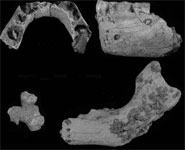New research, published in the Proceedings of the National Academy of Sciences, is now shedding some light on what were probably the last Neanderthals.
The research is based on a study of human fossils found during the past decade at the Sima de la Palomas, Murcia, Spain by Michael Walker, professor at Universidad de Murcia, and colleagues, and published by Michael Walker, João Zilhão and Alistair Pike, from the University of Bristol, and colleagues.
The human fossils from the upper levels of the Sima de las Palomas are anatomically clearly Neanderthals, and they are now securely dated to 40,000 years ago. They therefore establish the late persistence of Neanderthals in this southwestern cul-de-sac of Europe. This reinforces the conclusion that the Neanderthals were not merely swept away by advancing modern humans. The behavioral differences between these human groups must have been more subtle than the Middle-to-Upper Paleolithic technological contrasts might imply.
In addition, the Palomas Neanderthals variably exhibit a series of modern human features rare or absent in earlier Neanderthals. Either they were evolving on their own towards the modern human pattern, or more likely, they had contact with early modern humans around the Pyrenees. If the latter, it implies that the persistence of the Middle Paleolithic in Iberia was a matter of choice, and not cultural retardation.
From the Sima de las Palomas, other late Neanderthal sites, and recent discoveries of the earliest modern humans across Europe, a complex picture is emerging of shifting contact between behaviorally similar, if culturally and biologically different, human populations. We are coming to see them all more as people, flexibly making a living through the changing human and natural landscapes of the Late Pleistocene.
Paper
Late Neanderthals in Southeastern Iberia: Sima de las Palomas del Cabezo Gordo, Murcia, Spain Michael J. Walker, Josep Gibert, Mariano V. López, A. Vincent Lombardi, Alejandro Pérez-Pérez, Josefina Zapata, Jon Ortega, Thomas Higham, Alistair Pike, Jean-Luc Schwenninger, João Zilhão, Erik Trinkaus PNAS
Related articles
The Neanderthals: human ancestors or aliens from outer time? 18 May 2007
40,000-year-old skull shows both modern human and Neanderthal traits 15 January 2007
How modern were European Neanderthals? 24 August 2006
